Water heaters are one of the most power hungry devices on a boat. If you want to operate your boat mainly on solar power, you are probably interested to know how you can make the water heater system more efficient.
Most of the water heaters installed in boats are designed for use with shore power or big generators, and as a consequence they are big, poorly insulated, and use a powerful heating element in order to heat up really fast. All this is not favourable for running the water heater on just solar energy. It can still be done, but consider some of the ideas in this article to optimize your setup.
We managed to reduce the power demand of the water heater to just only 8% of what it used to be. Here are some idea's how to achieve this.
Hot Water Manager
You will probably want to use the solar power to heat up the water only after the batteries have already been fully charged. This means you will have to monitor the system voltage, and only after the voltage has reached some 14+ Volts, you have to switch on the water heater. Then again, if the sun goes down, you will have to remember to switch off the water heater otherwise it could drain your batteries for no good reason.
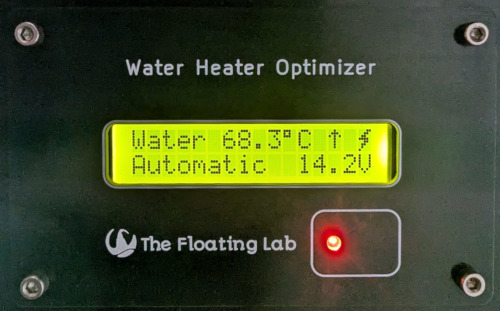
I designed the "Hot Water Manager" that takes care of all this automatically. It has been improved over the years and it has many power saving features.
Apart from powering the hot water only when there is enough energy available, it also saves power by reducing the hot water temperature to 40°C instead of the more standard 60°C. Yes, it also periodically raises the temperature to 60°C to prevent the development of Legionella contamination.
It has many more features, check it out at its dedicated project page "Hot Water Manager".
It is an open source project, so you can actually build it yourself without any obligation to me. But I also ran a small professional production batch, so you can buy a fully assembled mature version.
The Hot Water Manager works well with a standard water heater, but there are some things you can do to make the production of enough warm water for your needs even more efficient. The rest of this article is about these other ideas.
Buy a smaller water heater
How much tank volume do you actually need?
Metric Imperial
| Shower flow | Liter/minute | |
| Shower duration | Minutes | |
| Number of persons | Persons | |
| Shower temperature | °Celsius | |
| Cold water temperature | °Celsius | |
| Hot water temperature | °Celsius | |
| Cold water mixed in | Liters | |
| Hot water used | Liters | |
| Total water used | Liters |
Catamarans are usually designed for the charter industry so they come with a hot water tank volume of at least 40 Liters, with a thermostat usually fixed on 60°C, clearly intended to run only with shore power or via the generator. After mixing 40 liters of 60°C with "cold" water to get to the normal shower temperature of 38°C, you will actually end up with 120 liters of water with "shower-temperature".
120 Liters of shower temperature water!!! Do you really need that much?
If you actually only need 3 liters for showering (see the calculator) it means you are heating almost all of that water for nothing. A lot of that heat will leak away during the night so the next day you have to put in a lot of energy again, more than you are actually using for showering. Suitable small replacement water heaters don't have to be expensive, see the ZwerfCat example.
Improve the insulation
The hot water systems were not designed to be switched off during the night, and they loose a lot of valuable heat during this idle time. A loss of 1°C per hour is considered "good", the original water heater on ZwerfCat lost about 2°C per hour. A lot of energy can be preserved if you improve the insulation of the water heater. Wrap that thing in a blanket or build some insulated cabinet for it. Use insulation on the hoses connected to the water heater, especially close to the tank outlet.
Reduce the heating element power consumption to a quarter
Energy & time calculator
Metric Imperial
| Hot water tank volume | Liter | |
| Start temperature | °Celsius | |
| End temperature | °Celsius | |
| Heater power | Watt | |
| DC Voltage | Volt | |
| Energy required | kWh | |
| DC Current | Ampere | |
| AmpHours | Ah | |
| Time required | Minutes |
The heating element is usually optimized for fast heat-up times, which the typical cruiser doesn't need. The power rating of the heating element has no relation with the temperature, it just determines how fast it will be able to heat up the water to the desired temperature. If you can wait a little longer, you don't need such a high power heating element. Use the calculator to determine which power rating would be acceptable in your situation.
Usually the heating element consumes more power than your solar panels can produce, leading to draining of your batteries in a conventional setup, or frequent on/off cycling of the heating element when you use the Hot Water Manager. The system would work better if the heating element would use less power. At the end, it will take just as long to heat up the water, but with less on/off cycling and voltage fluctuations.
Luckily, there is an easy trick to reduce the power consumption to just 25% of what it used to be: If you halve the heater voltage, the power (Watt's) consumed will reduce to just a quarter. Yes, you read that right: Half the voltage will also reduce the current by a half, and since power is Voltage x Amperes, the power needed will now only be a quarter (and heating the same amount of water will consequently take four times longer). And yes, the heater element of the hot water system can run on lower voltages without any problem.
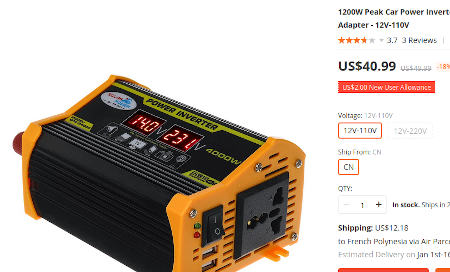
But how do you halve the voltage?
- If you have a 220V water heater, the only thing you have to do is to buy a small American 110V car inverter and use it to power the water heater. Even in the worst case (a heating element of 2000W) the inverter has to be only 500W and there are many cheap options available. A water heating element couldn't care less about wave form, so don't invest in a "nice sinus" capability but just buy the cheapest piece of junk you can find. You even don't need low voltage protection, because the Hot Water Manager will already take care of this.
- If you have an American installation (with a native 110V water heater), simply swap out the heating element for a European version (designed for 220V). Almost all water heaters are available in 110 and 220V versions and spare heater elements are commonly available. If the replacement 220V heating element is 2000 Watt, it will now only use 500 Watt on 110V, which is way more manageable.
Ideally, the power rating of the heating element (or a quarter of it if you apply my "voltage halving trick") should be less than the power rating of your solar installation.
Swap the bimetal thermostat
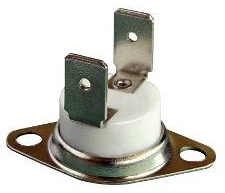
Most water heaters have a small bimetal switch (thermostat) in series with the heating element. It usually disconnects the connection at about 60°C. This way the water will stay around 60°C as long as the power remains. Our "problem" is that this rudimentary thermostate makes it impossible to reach a higher temperature.
Wait, what, a higher temperature? Isn't that the opposite of what we want to achieve? Well, suppose the water is 60°C and your batteries are full but there is still plenty of solar power available? Instead of throwing away this precious energy why not save some of it for the next day by heating up the water even more? If the next day is cloudy and you want to conserve energy, you will love it that you still have hot water available!
I think that a 80°C thermostat would be a good alternative. No, I don't think it is a good idea to just bypass the existing thermostat and depend on the Hot Water Manager to take care of it: If one day the Hot Water Manager fails or the relay overheats and welds shut, the heating element might stay on forever and convert your water heater into an actual boiler. The bimetal switch is a cheap safeguard to protect against reaching the boiling temperature.
Plumb into the generator coolant
On ZwerfCat we had a factory installation, with the coolant loop of the water heater plumbed into the port engine instead of into the generator. Maybe this is how it is always done on catamarans? But as a cruiser you probably run the generator more often than the engine, so why not plumb the coolant loop into the generator instead? (On ZwerfCat we sold our generator because we never needed it anymore after we installed 1500Watt of solar power, otherwise we would have done this).
ZwerfCat Example
ZwerfCat came with a 40 liter water heater, with a non-configurable 60°C bimetal switch. The heating element was "only" 700W, which means that our inverter had to draw about 55 Amps to power that thing. In favourable conditions we would switch the water heater on manually, and then have to remember to switch it off quickly when the sun got blocked. After all, we just wanted to shower and we actually didn't need all that water at 60°C, and we didn't want to consume any current from the batteries for just a silly reason. In practice, we didn't use the water heater very much.
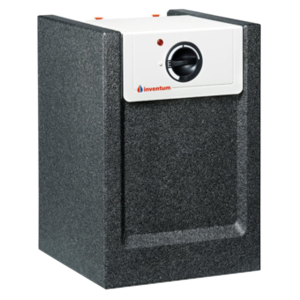
Out of frustration that we often had solar capacity to spare and a water heater willing to take it, but nobody thinking about it at the right time or forgetting to switch the water heater off again, I designed this Hot Water Manager. I don't own a floating lab for nothing!

The Hot Water Manager worked very well, but during this project I realized that every day we were heating up a lot of water for no good reason, and that we could actually be able to run the water heater even on cloudy days if it would just be smaller and use less power. How much smaller exactly? Well this led to the calculators you will find in this article. After measuring the flow of the shower and timing our shower durations, we discovered that we needed only a water heater 1/4th of the current size, and that we needed to only increase the temperature with 1/3 of what the old water heater was "programmed" to do. We could simply reduce the water heater energy demand to just 8% of what it used to be, and that was even without improving the insulation!
If you search for "boat water heaters", you will find the same, poorly insulated and very expensive water heater like we had. These days however, at least in Europe, domestic "under-the-sink water heaters" (also called "boilers") have become very popular: they are small (10L), fairly good insulated (energy labels are a big thing nowadays), and way cheaper than "boat water heaters". We got our 10L 2000W model for only 150 Euro. The only problem is that these domestic water heaters don't have a loop for the engine coolant.
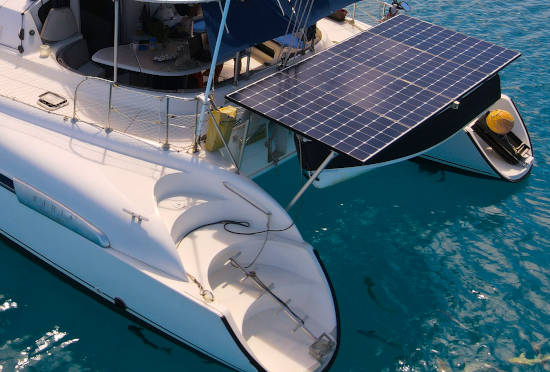
After doing some more math (see the calculators) we discovered that heating up 10 liters of water to "shower temperature" would take only 3 minutes and consume just half of the energy we normally use to make a pot of tea! If we have the engine running, we automatically have a big alternator running, and we can actually spare 3 minutes of power generation to just warm up the water in the hot water tank (if we want to, and if not already heated up by the solar panels). We rarely use the engines anyway and we suspect that when we are not using the engines a lot of heat actually leaks away via the coolant connections, so we decided to ditch the coolant heating feature and to get rid of the old 40L water heater. It also eliminated one engine failure mode (loss of coolant via the water heater) and a possible health hazard (coolant in the hot water tank) and it saved quite some space and weight in the process. Good deal after all!
Usually, the solar input will heat the water up to at least 60°C, which means that after mixing the output with cold water, we actually have 30 Liters of "shower temperature" water, which is enough for six showers (or two very wasteful showers)!
Quite an improvement for a modest investment!